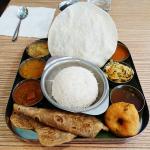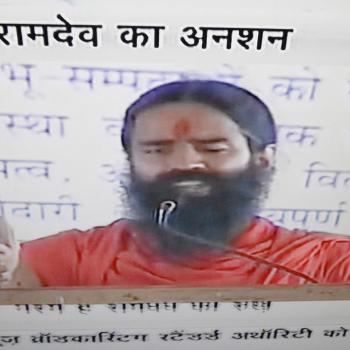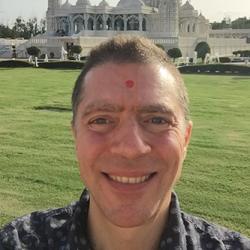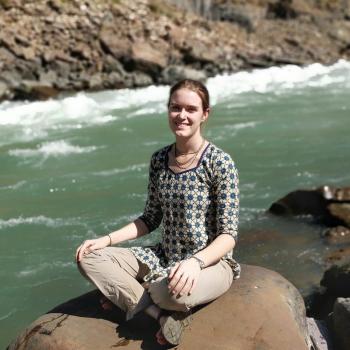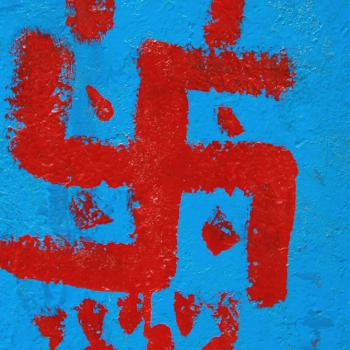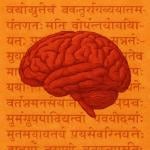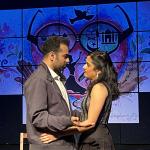The phenomenon of non-Indians adopting Hinduism is not new. However, the stories of how individuals came to the religion have not been regularly recorded. I hope to rectify that by time to time publishing interviews with those people who weren’t raised Hindu but now publicly identify as such, in the hopes of shedding some light on what drew them to Sanatana Dharma.
The following is an interview with Keshav Fulbrook (conducted via email), a man currently living in Missoula, Montana, raised Christian but now Hindu.
 When did you first get attracted to Hinduism?
When did you first get attracted to Hinduism?
I was raised with my grandparents for much of my early life and they took me regularly to Catholic mass. After my grandfather passed away and I lived with my mother, I was baptized Mormon. After again needing to switch homes to live with my father and stepmother, I was re-baptized Evangelical Christian in accordance with their faith.
I was always pretty spiritually inclined from as early as I can remember.
I was always seeking to understand the deepest tenets of the faith I found myself in. For me it was about seeking to understand the deeper nature and meaning of the world I found myself within. There wasn’t much else that really captured my attention quite like this question.
Eventually I came to the conclusion that I would not find the answers I was looking for in the Christian tradition. I could not help but follow the strange but persistent impulse that drove me to explore outside the boundaries of what was familiar.
I was always aware of Hinduism, even if vaguely at first. In my childhood this didn’t manifest as the intense interest and passion I have today. I would see a documentary on National Geographic or the Discovery Channel, read a fictional story set in India, or do a module in my third grade class on India which would briefly touch upon some basic features of Hindu faith or culture and it would register as familiar, though the seeds of that innate familiarity would not sprout fully for quite some time.
After I had decided to leave Christianity at the age of 13, I did more exploring through Western Neo-Paganism, New Ageism, and Buddhism. One thing I began to notice is that many of the most profound and perspective-altering ideas I came across were from Hindu sources like the Vedic Upanishads, Bhagavad Gita, Yoga Sutras, and more. Buddhist teachers would frequently make references to Hindu sources, but as my interest really began to flourish through my teenage years after seeing this, I wasn’t sure how to best approach it or where to start.
I moved to Montana at age 15 to live with my maternal aunt, and several years after this at age 19 met a person who would give lectures on the Bhagavad Gita every Sunday. This was where it really started for me, and the teachings I received through these classes added the last layer of kindling to the fire that was about to be lit within me.
The questions of theism in a dualistic sense, theism in a non-dualistic sense, and non-theism were jumbled in my head in a way that I felt I could make sense of, but had a difficult time really seeing clearly. I couldn’t keep from acknowledging the personal theistic divine, but at the same time acknowledged the impersonal formless divine. I saw the balance of these two perfectly reflected in the Gita, presented harmoniously and without contradiction. I would later find this same perfect balance reflected in all the Vedic teachings and literature I would be exposed to.
After a period of extreme turmoil and upheaval; losing a place of residence, job, long-term relationship, and being involved in a car accident which nearly ended my current incarnation, I had a lot of time to devote to meditation.
The upheavals in my life were gifts from Shani Deva in a way, and the subsequent transformation I feel took place through the insights I gained in my practice would not have been possible otherwise. I feel that I was able to appreciate experientially what had before only been a distant concept. It is at that point that the path I’m on today cemented. I dedicated a great deal of my time to sadhana and svadhyaya.
In 2015 I had my namakarana samskara at the temple in my home town, the Las Vegas Hindu Temple and Jain Center.
When and why did you first identify as Hindu?
At around age 19, I requested time off work for Ganesha Chaturthi. I had to explain to a doubtful employer that I was Hindu and get a signed letter explaining the festival. It was probably the first time that I said unequivocally that I was Hindu instead of saying something like “Hinduism is the closest to what I believe.” It was just a matter-of-fact, and the only thing that kept me from saying it confidently earlier was because I didn’t feel far enough along to say so.
Have you ever found there to be a conflict between any Western values you uphold and those of Hinduism?
There were definitely conflicts with values I used to uphold and those of Hinduism.
I think many people in the West who approach traditions other than their birth tradition had negative experiences with things like authority and enforced morality in the tradition they left. This can create a hyper-sensitivity to these things in other traditions, even if they manifest differently.
The beautiful thing about Hinduism is that it is extremely open and accommodating to a variety of perspectives, lifestyles, and interpretations. That being said, there is an emphasis on self-control and moderation (yama) as well as moral injunction (niyama) to help lead a life in line with constructive, universal, and natural principles (dharma). The goal of these moral injunctions is not shame nor mere oppressive restriction, and the consequences of breaking them are not eternal damnation. They are advice to help minimize suffering, and the individual is responsible for sowing the seeds they reap. Bhagavan is the giver of the fruit of action, but you are the sower of the seed. So to move to a more nuanced understanding of moral injunction was important. Ultimately it is taking responsibility for yourself and to make it easier on yourself while pursuing the four human goals or purusharthas.
How does your Hinduness manifest?
I would say it manifests moment-to-moment. I conduct panchayatana puja at home, learn suktams and stotrams, study, and meditate. Since raising public awareness about Hinduism in my community is a goal of mine, I occasionally speak on the subject.
What’s your spiritual path like?
I began my studies in earnest through Kauai Hindu Monastery’s distance learning courses. They are a Tamil Saiva Siddhanta parampara with many American adherents. The program was invaluable in helping me learn the basics of puja, understanding Hindu culture, and giving a very solid foundation in general.
The mukhya guru of the organization, Satguru Sivaya Subramuniyaswami, was himself an American who travelled to Sri Lanka where he met his guru Sri Yogaswami. I found his insights and recommendations, many of which were specifically geared towards the Western seeker, extremely helpful in orienting me in the vast ocean which is Sanatana Dharma.
After the course, I began my studies with Arsha Vidya Gurukulam and its diaspora of teachers in the Advaita Vedanta Sampradaya. Particularly this study is through the resources provided by Swami Tadatmananda, Swamini Pramananda, and Swami Paramarthananda.
I live in the small town of Missoula, Montana. While we have many Buddhist resources here, we have virtually no Hindu resources save for some individuals and families who occasionally meet for utsavas. Because of this, much of my instruction has taken place at a distance through the internet offered by these swamis. I have had the good fortune to visit Arsha Vidya Peetham in Pennsylvania and my most-direct guruji’s ashram in New Jersey.
How has the Hindu community responded to you?
The Hindu community has responded with unparalleled warmth and generosity. I have been incredibly blessed to have made lifelong friends in this community which started through online interactions on my blogs and posts, and turned into many opening their homes to me in my travels, invitations to speak at conferences, and other instances of hospitality which leave me feeling fortunate and grateful beyond words.
Have you ever been made to feel like less of a Hindu because of your race?
Most only by non-Hindus has this happened. The term ‘cultural appropriation’ has been leveled at me once or twice, but my view is that it is not about race and instead about the tradition itself and preserving the integrity of the teachings.
Hinduism is also not confined to a specific “race” historically.
Today, the island of Bali in Indonesia is majority Hindu. At one time, all of Southeast Asia including Cambodia, Thailand, Vietnam, Indonesia, and as far as the Philippines, were Hindu under the Majapahit and Chola empires. There are records of Greeks essentially becoming Hindu. The Khamb Baba or Heliodorus Pillar in Vidisha near Bhopal is a relic that stands as testament between the interaction of Greek and Hindu traditions. So when the issue of race is brought up, I don’t worry about it too much.
The issue of misappropriation is real, and particularly prevalent in some movements in the West, but I like to make the distinction between this phenomenon about ideas and customs versus just ‘being white’ and doing something, which is a much lower-resolution argument.
To use Rajiv Malhotra’s terminology, an Indian-born person can have a ‘Western frame’ and outsider perspective and visa-versa. It is ultimately dependent upon perspective stemming from ideas. They are influenced by culture of birth, but they are not permanent and immovable.
Do you think there’s a unique Western or American Hinduism developing, or will develop?
Hinduism is amazing in its ability to accomodate a great deal of regional variation. I think that there inevitably would be some regional variation in an American Hinduism. However, it must be approached with a great deal of caution and tact in my opinion.
Hinduism is a holistic system where every aspect of life has been given meaning, and our Rishis have given advice in these areas as well. So the procedure would be like transplanting a tree into new soil. The roots must remain intact, and if too much is removed and substituted, the tree may not bear its fruit.
Do you think it’s necessary for people adopting Hinduism to prioritize Indian dress or social cues? Take on a Sanskrit name?
My first guru I studied under, Satguru Sivaya Subramuniyaswami and his successor Bodhinathaswami emphasize the importance of this and for good reason in my opinion.
I had my namakarana samskara where I was given the name “Keshav.” I am known as Keshav by the Hindu community and people of Indian and South Asian descent. However, since my name has not yet legally been changed, I tend to go by “Brandon” at work and school. I do intend to legally change it soon.
Not everyone makes this choice, and that is fine of course in my opinion. If one is to take the samskaras however, it does a great deal to serve as a benchmark even for your own mind, and to help one settle more deeply into the tradition.
Gestures such as anjali mudra given during the greeting “namaste,” as well as choosing to eat with the hands, et cetera all have significance and their recommendations. At the same time, they are open invitations and not rigid dogmatisms.
The reality for most of us is that we must navigate in a world where we may need to be adaptable to several modes of living. The more accepted or normative they may become in Western contexts however, the easier others may find it, and that change starts on an individual level.
What’s your relationship with India?
I’m going for my first time to India this August. It has been a five year dream of mine come true.
I study Hindi language through my university and pursue Tamil, Sanskrit, and Nepali language study on my own time.
I was awarded a Hindi scholarship to Jaipur for nine months, and intend to make the most of my visit through pilgrimage to as many sites as I can get to. I find language to be a particularly rewarding avenue through which I connect with people in my faith community.
In the case of Sanskrit, so much is conveyed through Sanskrit which cannot be properly expressed in English alone that even my perfunctory studies have yielded a great deal of insight into the shastras I study with the guidance of my acharyas.
The language studies allow me to be immersed in culture and art (equally important as the philosophy and practices alone in my opinion) to extract added meaning and insight.
As a Hindu, India becomes punya bhumi; the most sacred abode of places of pilgrimage; the holy Ganga river, Kailasha, the Char Dham, jyotirlingas, and innumerable others. I look forward to this homecoming.
हरिः ॐ तत् सत्

